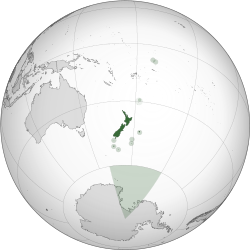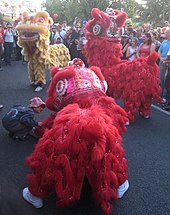Polynesians settled New Zealand in 1250–1300 CE and developed a distinctive
Māori culture, and
Europeans first made contact in 1642 CE. The introduction of potatoes and muskets triggered upheaval among
Māori early during the 19th century, which led to the inter-tribal
Musket Wars. In 1840 the British and Māori signed
a treaty making New Zealand a colony of the
British Empire. Immigrant numbers increased sharply and conflicts escalated into the
New Zealand Wars, which resulted in much
Māori land being confiscated in the mid North Island. Economic depressions were followed by periods of political reform, with
women gaining the vote during the 1890s, and a
welfare state being established from the 1930s. After World War II, New Zealand joined Australia and the United States in the
ANZUS security treaty, although the United States later, until 2010, suspended the treaty after New Zealand
banned nuclear weapons. New Zealand is part of the intelligence sharing among the Anglosphere countries, the
UKUSA Agreement. New Zealanders enjoyed one of the highest
standards of living in the world in the 1950s, but the 1970s saw a deep recession, worsened by oil shocks and the United Kingdom's entry into the
European Economic Community. The country underwent
major economic changes during the 1980s, which transformed it from a
protectionist to a liberalised
free-trade economy. Markets for New Zealand's agricultural exports have diversified greatly since the 1970s, with once-dominant exports of wool being overtaken by dairy products, meat, and recently wine.
During its long isolation, New Zealand developed a distinctive
biodiversity of animal, fungal and plant life. Most notable are the large number of unique
bird species, many of which became extinct after the arrival of humans and
introduced mammals. With a mild maritime climate, the land was mostly covered in forest. The country's varied topography and its sharp mountain peaks owe much to the
tectonic uplift of land and volcanic eruptions caused by the
Pacific and
Indo-Australian Plates clashing beneath the earth's surface.
The majority of
New Zealand's population is of
European descent; the indigenous Māori are the largest minority, followed by Asians and non-Māori Polynesians. English, Māori and
New Zealand Sign Language are the official languages, with English predominant. Much of
New Zealand's culture is derived from Māori and early British settlers. Early European art was dominated by landscapes and to a lesser extent portraits of Māori. A recent resurgence of Māori culture has seen their traditional arts of
carving, weaving and
tattooing become more mainstream. Many artists now combine Māori and Western techniques to create unique art forms. The country's culture has also been broadened by globalisation and increased
immigration from the Pacific Islands and Asia. New Zealand's diverse landscape provides many opportunities for outdoor pursuits and has provided the backdrop for a number of big budget movies.
Etymology

Detail from a 1657 map showing the western coastline of "Nova Zeelandia"
Aotearoa (often translated as "land of the long white cloud") is the current Māori name for New Zealand, and is also used in
New Zealand English. It is unknown whether Māori had a name for the whole country before the arrival of Europeans, with
Aotearoa originally referring to just the
North Island.
Abel Tasman sighted New Zealand in 1642 and called it
Staten Landt, supposing it was connected to a landmass of the same name at the southern tip of South America.
[13] In 1645 Dutch
cartographers renamed the land
Nova Zeelandia after the
Dutch province of
Zeeland.
[14][15] British explorer
James Cook subsequently
anglicised the name to New Zealand.
[n 8]
Māori had several traditional names for the two main islands, including
Te Ika-a-Māui (the fish of
Māui) for the North Island and
Te Wai Pounamu (the waters of
greenstone) or
Te Waka o Aoraki (the canoe of Aoraki) for the
South Island. Early European maps labelled the islands North (North Island), Middle (South Island) and South (
Stewart Island / Rakiura).
[17] In 1830 maps began to use North and South to distinguish the two largest islands and by 1907 this was the accepted norm.
[18] The
New Zealand Geographic Board discovered in 2009 that the names of the North Island and South Island had never been formalised, but there are now plans to do so.
[19] The board is also considering suitable Māori names,
[20] with
Te Ika-a-Māui and
Te Wai Pounamu the most likely choices according to the chairman of the
Māori Language Commission.
[21]
Biodiversity
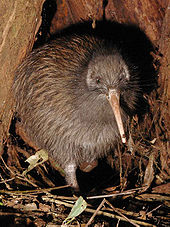
The endemic flightless
kiwi is a national icon.
New Zealand's
geographic isolation for 80 million years
[151] and island
biogeography is responsible for the country's unique
species of
animals,
fungi and
plants. They have either
evolved from
Gondwananwildlife or the few organisms that have
managed to reach the shores flying, swimming or
being carried across the sea.
[152] About 82 percent of New Zealand's indigenous
vascular plants are
endemic, covering 1,944 species across 65
genera and includes a single
family.
[153][154] The number of fungi recorded from New Zealand, including lichen-forming species, is not known, nor is the proportion of those fungi which are endemic, but one estimate suggests there are approximately 2300 species of lichen-forming fungi in New Zealand
[153] and 40 percent of these are endemic.
[155] The two main types of forest are those dominated by broadleaf trees with emergent
podocarps, or by
southern beech in cooler climates.
[156] The remaining vegetation types consist of grasslands, the majority of which are
tussock.
[157]
Before the arrival of humans an estimated 80 percent of the land was covered in forest, with only
high alpine, wet, infertile and volcanic areas without trees.
[158] Massive
deforestation occurred after humans arrived, with around half the forest cover lost to fire after Polynesian settlement.
[159] Much of the remaining forest fell after European settlement, being logged or cleared to make room for pastoral farming, leaving forest occupying only 23 percent of the land.
[160]
Other indigenous animals are represented by reptiles (
tuataras,
skinks and
geckos),
[164] frogs, spiders (
katipo), insects (
weta) and snails.
[165][166] Some, such as the
wrens and tuatara, are so unique that they have been called
living fossils. Three species of bats (
onesince extinct) were the only sign of native land mammals in New Zealand until the 2006 discovery of bones from a unique, mouse-sized land mammal at least 16 million years old.
[167][168] Marine mammals however are abundant, with almost half the world's
cetaceans(whales, dolphins, and
porpoises) and large numbers of
fur seals reported in New Zealand waters.
[169] Many seabirds breed in New Zealand, a third of them unique to the country.
[170] More penguin species are found in New Zealand than in any other country.
[171]
Since human arrival almost half of the country's vertebrate species have become extinct, including at least fifty one birds, three frogs, three lizards, one freshwater fish, and one bat, and four plant species have become extinct.
[162] Others are endangered or have had their range severely reduced.
[162] The number of fungi which have become extinct, endangered or reduced in range is not known. However New Zealand conservationists have pioneered several methods to help threatened wildlife recover, including island sanctuaries, pest control, wildlife translocation, fostering, and ecological
restoration of islands and
other selected areas.
[172][173][174][175] According to the 2012
Environmental Performance Index, New Zealand is considered a "strong performer" in environmental protection, ranking 14th out of 132 assessed countries.
[176]
Economy
Historically, extractive industries have contributed strongly to New Zealand's economy, focussing at different times on sealing, whaling,
flax, gold,
kauri gum, and native timber.
[185]With
the development of refrigerated shipping in the 1880s meat and dairy products were exported to Britain, a trade which provided the basis for strong economic growth in New Zealand.
[186] High demand for agricultural products from the United Kingdom and the United States helped New Zealanders achieve higher living standards than both Australia and Western Europe in the 1950s and 1960s.
[187] In 1973 New Zealand's export market was reduced when the United Kingdom joined the European Community
[188] and other compounding factors, such as the
1973 oil and
1979 energy crisis, led to a severe
economic depression.
[189] Living standards in New Zealand fell behind those of Australia and Western Europe, and by 1982 New Zealand had the lowest per-capita income of all the developed nations surveyed by
the World Bank.
[190] Since 1984, successive governments engaged in major
macroeconomic restructuring (known first as
Rogernomics and then
Ruthanasia), rapidly transforming New Zealand from a highly
protectionist economy to a liberalised
free-trade economy.
[191][192]
Unemployment peaked above 10 percent in 1991 and 1992,
[193] following the
1987 share market crash, but eventually fell to a record low of 3.4 percent in 2007 (ranking fifth from twenty-seven comparable OECD nations).
[194] However, the
global financial crisis that followed had a major impact on New Zealand, with the GDP shrinking for five consecutive quarters, the longest recession in over thirty years,
[195][196] and unemployment rising back to 7% in late 2009.
[197] As of May 2012, the general unemployment rate was around 6.7%, while the unemployment rate for youth aged 15 to 21 was 13.6%.
[198] New Zealand has experienced a series of "
brain drains" since the 1970s
[199] that still continue today.
[200] Nearly one quarter of highly skilled workers live overseas, mostly in Australia and Britain, which is the largest proportion from any developed nation.
[201] In recent years, however, a "
brain gain" has brought in educated professionals from Europe and lesser developed countries.
[202]
Trade
New Zealand is heavily dependent on international trade,
[204] particularly in
agricultural products.
[205] Exports account for a high 24 percent of its output,
[134] making New Zealand vulnerable to international commodity prices and global
economic slowdowns. Its principal export industries are agriculture, horticulture,
fishing, forestry and mining, which make up about half of the country's exports.
[206] Its major export partners are Australia, United States, Japan, China, and the United Kingdom.
[134] On 7 April 2008, New Zealand and China signed the
New Zealand China Free Trade Agreement, the first such agreement China has signed with a developed country.
[207][208] The service sector is the largest sector in the economy, followed by manufacturing and construction and then farming and raw material extraction.
[134] Tourism plays a significant role in New Zealand's economy, contributing $15.0 billion to New Zealand’s total GDP and supporting 9.6 percent of the total workforce in 2010.
[209] International visitors to New Zealand increased by 3.1 percent in the year to October 2010
[210] and are expected to increase at a rate of 2.5 percent annually up to 2015.
[209]
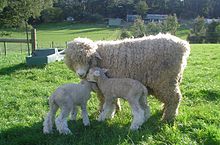
Wool has historically been one of New Zealand's major exports.
Wool was New Zealand’s major agricultural export during the late 19th century.
[185] Even as late as the 1960s it made up over a third of all export revenues,
[185] but since then its price has steadily dropped relative to other commodities
[211] and wool is no longer profitable for many farmers.
[212] In contrast dairy farming increased, with the number of dairy cows doubling between 1990 and 2007,
[213] to become New Zealand's largest export earner.
[214] In the year to June 2009, dairy products accounted for 21 percent ($9.1 billion) of total merchandise exports,
[215] and the country's largest company,
Fonterra, controls almost one-third of the international dairy trade.
[216] Other agricultural exports in 2009 were meat 13.2 percent, wool 6.3 percent, fruit 3.5 percent and fishing 3.3 percent.
New Zealand's wineindustry has followed a similar trend to dairy, the number of vineyards doubling over the same period,
[217] overtaking wool exports for the first time in 2007.
[218][219]
Infrastructure
In 2008, oil, gas and coal generated approximately 69 percent of
New Zealand's gross energy supply and 31% was generated from
renewable energy, primarily
hydroelectric power and
geothermal power.
[220] New Zealand's transport network includes 93,805 kilometres (58,288 mi) of roads, worth 23 billion dollars,
[221] and 4,128 kilometres (2,565 mi) of railway lines.
[222] Most major cities and towns are linked by bus services, although the private car is the predominant mode of transport.
[223] The
railways were privatised in 1993, then re-purchased by the government in 2004 and vested into a
state owned enterprise.
[224] Railways run the length of the country, although most lines now carry freight rather than passengers.
[225] Most international visitors arrive via air
[226] and New Zealand has
six international airports, although currently only the
Auckland and
Christchurch airports connect directly with countries other than Australia or Fiji.
[227] The
New Zealand Post Office had a monopoly over telecommunications until 1989 when
Telecom New Zealand was formed, initially as a state-owned enterprise and then
privatised in 1990.
[228] Telecom still owns the majority of the telecommunications infrastructure, but competition from other providers has increased.
[229] The
United Nations International Telecommunication Union ranks New Zealand 12th in the development of information and communications infrastructure, having moved up four places between 2008 and 2010.
[230]
Demography

New Zealand's historical population (black) and projected growth (red)
The population of New Zealand is approximately 4.4 million.
[231] New Zealand is a predominantly urban country, with 72 percent of the population living in 16 main urban areas and 53 percent living in the four largest cities of
Auckland,
Christchurch,
Wellington, and
Hamilton.
[232] New Zealand cities generally rank highly on international livability measures. For instance, in 2010 Auckland was ranked the world's 4th most
liveable city and Wellington the 12th by the
MercerQuality of Life Survey
[233]
The life expectancy of a New Zealand child born in 2008 was 82.4 years for females, and 78.4 years for males.
[234] Life expectancy at birth is forecast to increase from 80 years to 85 years in 2050 and infant mortality is expected to decline.
[235] New Zealand's
fertility rate of 2.1 is relatively high for a developed country, and natural births account for a significant proportion of
population growth. Subsequently, the country has a young population compared to most industrialized nations, with 20 percent of New Zealanders being 14 years-old or younger.
[236] By 2050 the population is forecast to reach 5.3 million, the median age to rise from 36 years to 43 years and the percentage of people 60 years of age and older to rise from 18 percent to 29 percent.
[235]
Ethnicity and immigration
In the 2006 census, 67.6 percent identified ethnically as European and 14.6 percent as Māori.
[237] Other major ethnic groups include
Asian (9.2 percent) and Pacific peoples (6.9 percent), while 11.1 percent identified themselves simply as a "New Zealander" (or similar) and 1 percent identified with other ethnicities.
[238][n 10] This contrasts with 1961, when the census reported that the population of New Zealand was 92 percent European and 7 percent Māori, with Asian and Pacific minorities sharing the remaining 1 percent.
[240] While the
demonym for a New Zealand citizen is New Zealander, the informal "
Kiwi" is commonly used both internationally
[241] and by locals.
[242] The Māori loanword
Pākehā usually refers to
New Zealanders of European descent, although some reject this appellation,
[243][244] and some Māori use it to refer to all non-Polynesian New Zealanders.
[245]
The Māori were the first people to reach New Zealand, followed by the early European settlers. Following colonisation, immigrants were predominantly from Britain, Ireland and Australia because of restrictive policies similar to the
white Australian policies.
[246] There was also significant Dutch,
Dalmatian,
[247] Italian, and German immigration, together with indirect European immigration through Australia, North America, South America and South Africa.
[248] Following the
Great Depressionpolicies were relaxed and migrant diversity increased. In 2009–10, an annual target of 45,000–50,000 permanent residence approvals was set by the New Zealand Immigration Service — more than one new migrant for every 100 New Zealand residents.
[249] Twenty-three percent of New Zealand's population were born overseas, most of whom live in the Auckland region.
[250] While most have still come from the United Kingdom and Ireland (29 percent), immigration from East Asia (mostly mainland China, but with substantial numbers also from Korea, Taiwan, Japan, and Hong Kong) is rapidly increasing the number of people from those countries.
[251] The number of fee-paying
international students increased sharply in the late 1990s, with more than 20,000 studying in public
tertiary institutions in 2002.
[252]
Education and religion
Primary and secondary schooling is compulsory for children aged 6 to 16, with the majority attending from the age of 5.
[262] There are 13 school years and attending
state (public) schools is free to New Zealand citizens and permanent residents from a person's 5th birthday to the end of the calendar year following their 19th birthday.
[263] New Zealand has an adult literacy rate of 99 percent,
[134] and over half of the population aged 15 to 29 hold a tertiary qualification.
[262][n 13] There are five types of government-owned tertiary institutions: universities, colleges of education,
polytechnics, specialist colleges, and
wānanga,
[264] in addition to private training establishments.
[265] In the adult population 14.2 percent have a
bachelor's degree or higher, 30.4 percent have some form of secondary qualification as their highest qualification and 22.4 percent have no formal qualification.
[266] The OECD's
Programme for International Student Assessment ranks New Zealand's education system as the 7th best in the world, with students performing exceptionally well in reading, mathematics and science.
[267]
Christianity is the predominant religion in New Zealand, although its society is among the most secular in the world.
[268] In the 2006 Census, 55.6 percent of the population identified themselves as Christians, while another 34.7 percent indicated that they had no religion (up from 29.6 percent in 2001) and around 4 percent affiliated with other religions.
[269][n 14] The main Christian denominations are
Anglicanism,
Roman Catholicism,
Presbyterianism and
Methodism. There are also significant numbers of Christians who identify themselves with
Pentecostal,
Baptist, and
Latter-day Saint churches and the New Zealand-based
Ratana church has adherents among Māori. According to census figures, other significant minority religions include
Hinduism,
Buddhism, and
Islam.
[260][270]
List of cities in New Zealand
(June 2010 population estimates)[271] | 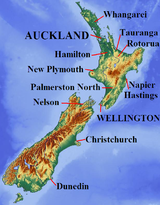 |
|---|
| Rank | City Name | Region | Pop. | Rank | City Name | Region | Pop. |
|---|
| 1 | Auckland | Auckland Region | 1,397,300 | 7 | Dunedin | Otago Region | 118,400 |
| 2 | Wellington | Wellington Region | 395,600 | 8 | Palmerston North | Manawatu-Wanganui Region | 83,300 |
| 3 | Christchurch | Canterbury Region | 375,900 | 9 | Nelson | Nelson | 61,100 |
| 4 | Hamilton | Waikato Region | 209,300 | 10 | Rotorua | Bay of Plenty Region | 56,100 |
| 5 | Napier-Hastings | Hawke's Bay Region | 125,000 | 11 | New Plymouth | Taranaki Region | 53,000 |
| 6 | Tauranga | Bay of Plenty Region | 122,200 | 12 | Whangarei | Northland Region | 52,500 |

Late twentieth-century house-post depicting the navigator
Kupe fighting two sea creatures


